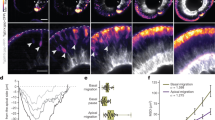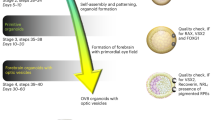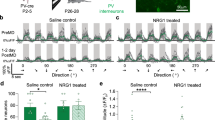Abstract
THE transplantation of embryonic eyes in Amphibia is a long established approach for testing the ability of nerve fibres to grow through unusual regions of the central nervous system1,2. As the behaviour of growing ectopic fibres may disclose the mechanisms of axonal guidance3–7, this approach has recently attracted new interest8–12. We are studying the behaviour of optic fibres entering the spinal cord from a heterotopic eye grafted on to the dorsal trunk region of Xenopus embryos10,11. Here we report on the paths used by ectopic fibres to travel in the spinal cord, their possible termination in the hindbrain, and their ability to reach the optic tectum.
This is a preview of subscription content, access via your institution
Access options
Subscribe to this journal
Receive 51 print issues and online access
$199.00 per year
only $3.90 per issue
Buy this article
- Purchase on Springer Link
- Instant access to full article PDF
Prices may be subject to local taxes which are calculated during checkout
Similar content being viewed by others
References
Lewis, W. H. Am. J. Anat. 6, 461–471 (1907).
May, R. M. & Detwiler, S. R. J. exp. Zool 43, 83–103 (1925).
Weiss, P. in Analysis of Development (eds Willier, B. H., Weiss, P. & Hamburger, V.) 346–401 (W. B. Saunders, Philadelphia, 1955).
Hamburger, V. J. cell. comp. Physiol. 60, Suppl. 1, 81–92 (1962).
Sperry, R. W. Proc. natn. Acad. Sci. U.S.A. 50, 703–710 (1963).
Van der Loos, H. Bull. Johns Hopkins Hosp. 117, 228–250 (1965).
Jacobson, M. Developmental Neurobiology (Plenum, New York, 1978).
Sharma, S. C. Nature new Biol. 238, 286–287 (1972).
Constantine-Paton, M. & Capranica, R. R. J. comp. Neurol. 170, 17–32 (1976).
Van der Loos, H. Prog. Brain Res. 45, 259–278 (1976).
Giorgi, P. P. & Van der Loos, H. Acta anat. 99, 349 (1977).
Katz, M. J. & Lasek, R. J. Science 199, 202–204 (1978).
Nieuwkoop, P. D. & Faber, J. Normal Table of Xenopus laevis (North-Holland, Amsterdam, 1956).
Gurdon, J. B. in Methods in Developmental Biology (eds Wilt, F. H. & Wessels, N. K.) 75–84 (Crowell, New York, 1967).
Flickinger, R. A. J. exp. Zool. 112, 465–484 (1949).
Holmes, W. Anat. Rec. 86, 157–187 (1943).
Giorgi, P. P. (in preparation).
Herrick, C. J. J. comp. Neurol. 81, 307–331 (1944).
Fite, K. V. & Scalia, F. in The Amphibian VisualSystem (ed. Fite, K. V.) 87–118 (Academic,New York, 1976).
Gaze, R. M., Keating, M. J. & Chung, S. H. Proc. R. Soc. B 185, 301–330 (1974).
Jacobson, M. Brain Res. 127, 55–67 (1977).
Roth, S. & Marchase, R. B. in Neuronal Recognition (ed. Barondes, S. H.) 227–248 (Chapman and Hall, London, 1976).
Author information
Authors and Affiliations
Rights and permissions
About this article
Cite this article
GIORGI, P., VAN DER LOOS, H. Axons from eyes grafted in Xenopus can grow into the spinal cord and reach the optic tectum. Nature 275, 746–748 (1978). https://doi.org/10.1038/275746a0
Received:
Accepted:
Issue Date:
DOI: https://doi.org/10.1038/275746a0
This article is cited by
-
A Novel Method for Inducing Nerve Growth via Modulation of Host Resting Potential: Gap Junction-Mediated and Serotonergic Signaling Mechanisms
Neurotherapeutics (2015)
-
Regeneration of the frog optic nerve
Neurochemical Pathology (1986)
Comments
By submitting a comment you agree to abide by our Terms and Community Guidelines. If you find something abusive or that does not comply with our terms or guidelines please flag it as inappropriate.



